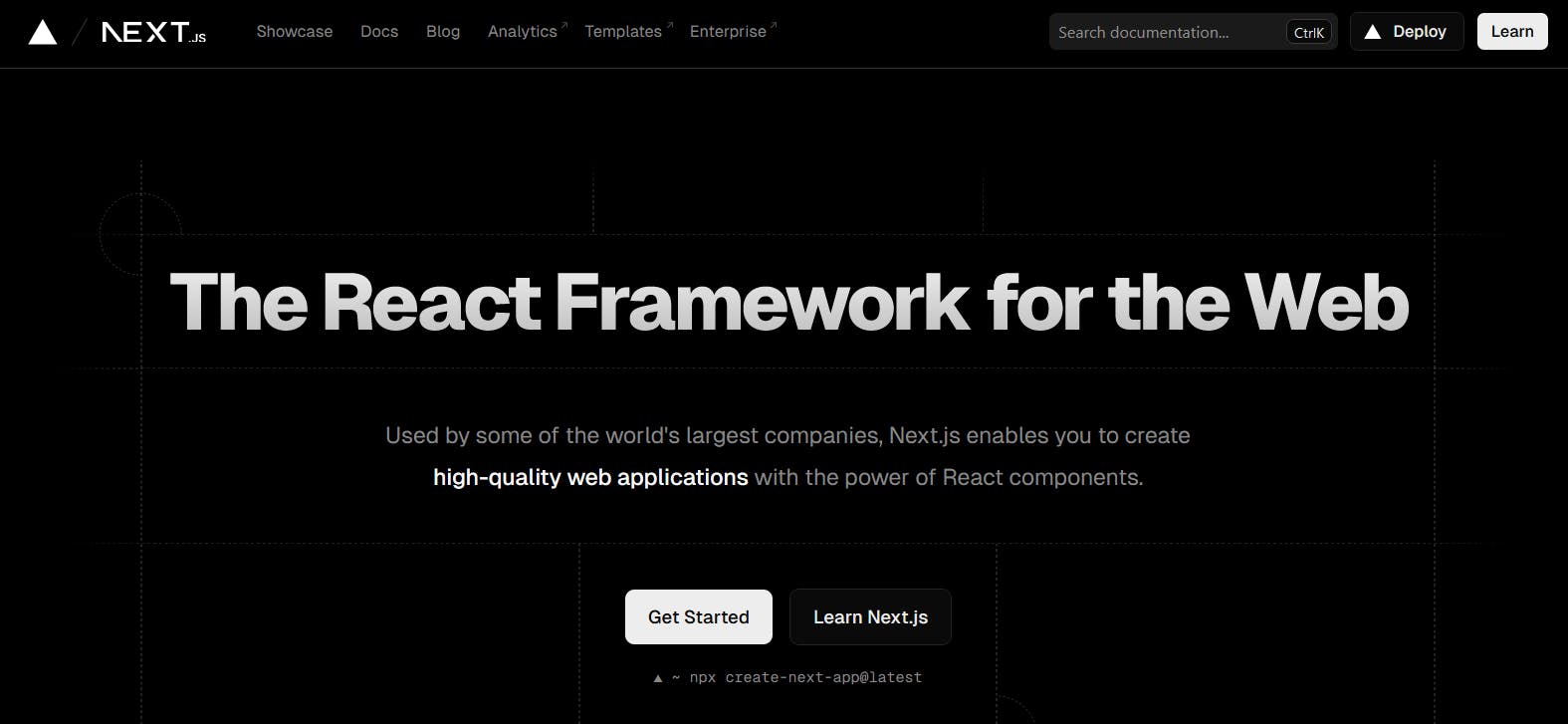
In modern web development, we have so many frameworks to keep track of, making choosing the right framework a crucial step when building websites and apps. The selection greatly influences your project’s long-term architecture, performance, and scalability.
In JavaScript alone, we have frameworks ranging from the big 4, React, Vue, Svelte, and Angular, to their meta-frameworks such as Next, Astro, Remix, Gatsby, Nuxt, Sveltekit, Analog, and so on.
Amongst these meta-frameworks, two of the prominent ones that stand out are SvelteKit and Next.js. They stand out because of their robust features and capabilities. However, understanding their unique strengths can guide developers in making the best choice for their next project’s needs.
In this article, let’s explore these two meta-frameworks to see how they compare to one another.
Before we look at the comparison between these two frameworks, let's quickly look at a brief overview of each.
What is SvelteKit?

SvelteKit is a meta-framework of Svelte i.e. it is built upon the lightweight Svelte library.
SvelteKit offers simplicity without sacrificing performance and that’s the design philosophy of this framework. One of the key benefits is the effortless transition from Svelte to SvelteKit. SvelteKit introduces a seamless onboarding for developers who are already familiar with Svelte.
It is powered by Svelte and Vite.
Some of the unique features of SvelteKit include:
- Routing: SvelteKit adopts a file-based routing system, making it easy to define application routes and their corresponding components. This approach enhances project organization and maintainability. Routing in SvelteKit is client-side by default with automatic preloading.
- Server-side Rendering (SSR), Static Site Generation (SSG), and Incremental Static Regeneration (ISR) Capabilities: SvelteKit allows developers to choose the best rendering approach based on their content needs. Whether it is SSR, SSG, or ISR, SvelteKit ensures optimal performance and user experience.
- Image Optimization: SvelteKit's automatic image optimization results in faster page load times, contributing to a smoother user experience.
- Code Splitting: With automatic code splitting capabilities, SvelteKit optimizes initial page load time by efficiently managing JavaScript bundles. This feature contributes to enhanced application performance and user satisfaction.
- SEO Optimization: SvelteKit excels in SEO optimization, leveraging server-side rendering and static site generation to ensure search engine discoverability.
Other advanced features include offline support for PWA (Progressive Web Apps), build optimization, prerendering, and simplified data fetching by offering built-in support for load and action functions, etc.
Here are some websites built with Prismic and SvelteKit:
To learn how to use SvelteKit, check out this tutorial on the framework.
What is Next.js?

Just like SvelteKit, Next.js is built upon the parent framework, React. In essence, Next.js to React is like SvelteKit to Svelte or Nuxt to Vue.
Next.js is a feature-rich framework that enables developers to create high-quality web applications. Powered by React, Turbopack, and Speedy Web Compiler, Next.js is built on a foundation of fast, production-grade toolings. Next.js uses the React component with additional optimization features that we will see below.
Some of the unique features of Next.js include:
- Routing: Like SvelteKit, Next.js utilizes a file-based routing system. This approach does not only provide control over route management, it also facilitates a dynamic routing configuration and allows for flexibility and scalability. You don’t need external packages for route implementation like React does with react-router and others.
- Server-side Rendering (SSR), Static Site Generation (SSG), and Incremental Static Regeneration (ISR) Capabilities: Similar to SvelteKit, Next.js also provides different rendering options: SSR, SSG, and ISR.
- Image Optimization: Like SvelteKit, Next.js also prioritizes performance. One of the ways Next.js handles performance is by automatically optimizing images, reducing file sizes, and thus, increasing page load time which in turn increases user experience.
- Code Splitting: With built-in support for automatic code splitting, Next.js ensures efficient initial page load time ensuring a seamless user experience across various devices and network conditions.
- Partial Pre-rendering: This feature is still in the experimental phase but can be used and tested in development.
- SEO Optimization: Just like SvelteKit, Next.js also excels in SEO optimization. Additionally, both frameworks offer robust metadata management capabilities, enhancing SEO performance further.
Other Next.js features include strong support for TypeScript with better type-checking for better code maintainability and developer productivity. It also offers an array of data fetching mechanisms like getStaticProps, getServerSideProps, and API routes.
To learn how to use Prismic and Next.js, check out this tutorial or watch a video on it.
Here are some websites built using Next.js with Prismic
Empower your marketing team to release pages quickly!
Sign up for free to see how Prismic lets you build with your preferred tech stack while enabling marketers to create high-performing, on-brand pages independently. Free up your time for the dev work you love!
SvelteKit versus Next.js
It is good to note that these comparisons are so that you can make an informed choice when choosing one framework over the other in your projects. For a particular project, you may choose to go for SvelteKit because it is the better option, while in another case or project, Next.js may prove to be the better option for your project.
With that, let’s look at how both frameworks compare in these areas.
Framework learning curve
Svelte being a newer framework compared to Next.js, offers an easier learning curve compared to React.js. SvelteKit focuses on simplicity and has clear and easy-to-understand documentation. It is easy to understand because it makes use of JavaScript and Svelte for templating.
Next.js, on the other hand, benefits from React's established ecosystem and documentation. It requires you to learn React, JSX, and JavaScript. Unless you’re already familiar with React, learning Next.js as a newbie isn’t as easy as it would be for a SvelteKit newbie.
Approach to server-side rendering (SSR)
Both SvelteKit and Next.js have strong support for server-side rendering. However, their approach to SSR is a bit different. SvelteKit utilizes JavaScript for server-side rendering, aiming for smaller bundle sizes. Next.js primarily relies on React's virtual DOM for rendering, which can lead to larger bundle sizes compared to SvelteKit. This can impact initial load times and overall application performance, making SvelteKit potentially more suitable for performance-critical applications.
State management
SvelteKit offers a reactive and lightweight approach to state management as it uses its built-in store. It leverages Svelte’s store for all components, making managing application state more integrated.
In contrast, Next.js is framework-agnostic when it comes to state management. This means that while it doesn't have a built-in state management feature, it can seamlessly integrate with popular statement libraries. It allows developers to choose from various state management solutions like Zustand, Mobx, Redux, and so on.
Load time and bundle size
For load time, SvelteKit often boasts faster load times due to its smaller bundles. Next.js's extensive functionality may lead to larger bundles. However, utilizing Next.js's advanced optimization techniques can reduce this disparity in certain scenarios.
Developer experience
Next.js offers more customization options for advanced use cases but potentially requires more setup effort. Next.js may suit developers who prefer control and customization.
Conversely, SvelteKit focuses on simplicity, minimal code, and performance. This translates into a straightforward setup and minimal configuration requirements.
Community support/ecosystem
With over 119k stars and 3175 active contributors on GitHub, Next.js boasts a larger and more established community. The benefits of this big community mean a huge array of libraries, resources, and readily available tools that are available for your development growth. Documentation of the framework isn’t left out either, as there will be constant updates and advancements.
In contrast, SvelteKit has 17.4k stars with 512 active contributors. Although the SvelteKit community is rapidly growing, it has a smaller community and, as such, has fewer available resources.
React based
Svelte based
Easier for React users
Easier for beginners
Built-in support for SSR
Built-in support for SSR
Uses external state management libraries like Redux
Leverages its built-in Svelte’s store
Larger bundle size
Faster load time and smaller bundle size
Suitable for developers who prefer control and customization
Focuses on simplicity and performance, hence better Developer Experience than Next.js
Larger Community support
Rapidly growing but smaller than Next.js
SvelteKit vs. Next.js: which should you choose?
Now, you may be wondering which of these frameworks you should choose and when you should choose it.
Short answer: Choose the most popular one, Next.js, based on web developer job requirements if you want a plethora of job opportunities. Choose Svelte if you value simplicity - leaner, efficient, and yet performant code.
Long answer: It all depends on what your project requires and what works for your team. If your team members are familiar with React, Next.js is the right option. Also, if you want configuration options and its robust features, then Next.js is the right option. Next.js’ server-side rendering, code splitting, lazy loading, and its new and experimental partial pre-rendering make it a better choice for building a site with dynamic content.
On the other hand, if your team is familiar with Svelte, then SvelteKit is the right choice. Many of its features are similar to Next.js, like server-side rendering, code splitting, image optimization, and so on, and yet it lauds minimal code and a better developer experience.
SvelteKit vs. Next.js: try building a site with each!
If you're still considering which framework might be right for you, consider putting them head-to-head by trying these full step-by-step tutorials! Build a dark, modern, animated website with either SvelteKit or Next.js, GSAP, Prismic, Tailwind, and TypeScript!
Conclusion
As developers navigate the vast array of frameworks available today, understanding the nuances between SvelteKit and Next.js is crucial. SvelteKit and Next.js share several similarities, making them attractive options for building modern websites and applications.
Both Next.js and SvelteKit:
- Offer server-side rendering (SSR), static site generation (SSG), and incremental static regeneration (ISR) for optimal performance.
- Support image optimization and code splitting by default.
- Provide file-based routing for organizing application structure.
- Can be deployed on various platforms, offering flexibility for hosting options.
Similarly, several unique attributes exist between the two frameworks, which matter to developers when choosing one framework over the other for a project. Best of luck!







